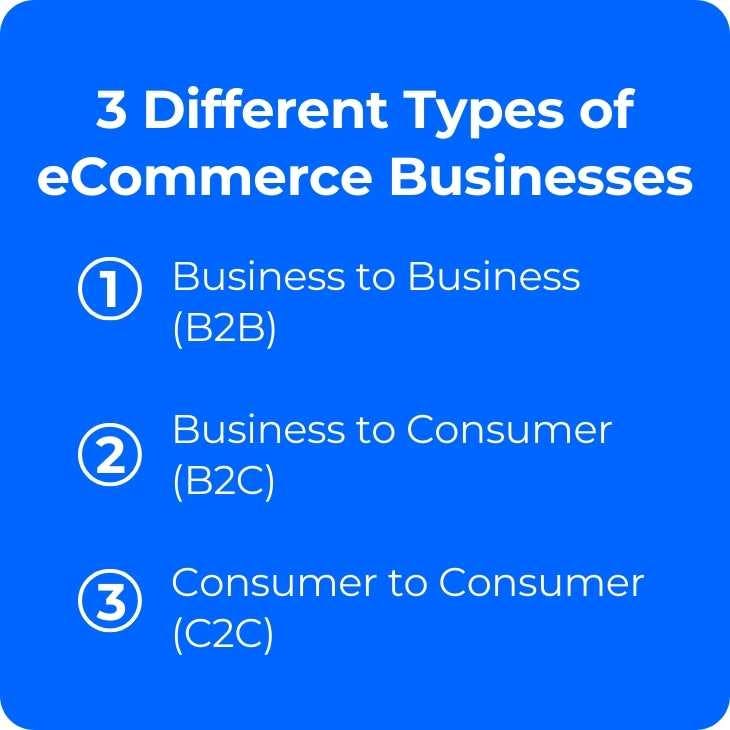Are you interested in registering an eCommerce business in Hong Kong? This guide outlines everything you need to know to get started!
What Is an eCommerce Business?
An e-commerce business is a company that buys and sells goods or services online through a website, marketplace, or social channel, without needing a physical storefront. You can sell physical products, digital goods, or services, with orders placed online, paid via a payment gateway, and fulfilled by shipping or instant digital delivery.
There are three different types of eCommerce businesses:
Business to Business (B2B)
Companies sell to other companies (e.g., manufacturers or distributors supplying retailers).
Business to Consumer (B2C)
Brands sell directly to consumers via an online store or marketplace listing (e.g., Shopify store, Amazon listing).
Consumer to Consumer (C2C)
Individuals sell to other individuals on third-party platforms (e.g., Facebook Marketplace, Carousell).

Steps to Register and Launch Your E-Commerce Business in Hong Kong
The general process of starting an online business in Hong Kong involves the following steps:
- Incorporate a company
- Open a bank account or business payment account
- Check licences and map product rules
- Choose your platform/marketplace and fulfilment model
- Set up payments and core integrations
- Ensure ongoing compliance
Step 1: Incorporate a Company
For most online sellers, a private limited company offers limited liability, credibility, and room to scale.
Common Business Structures
- Sole Proprietorship – simple setup, unlimited personal liability.
- Partnership – shared liability and profit among partners.
- Private Limited Company – a separate legal entity with limited liability for shareholders. Ideal for eCommerce due to credibility and investor appeal.
After Choosing the Structure
- Choose a company name (doesn’t have to match your store name).
- Submit incorporation documents to the Hong Kong Companies Registry via e-filing.
- Receive your Certificate of Incorporation and Business Registration Certificate electronically (often around 1 hour for straightforward e-filings)
Government Fees (2025/26, e-file)
- Form NNC1: HKD 1,545
- Business Registration Certificate (1-year): HKD 2,200 (levy waived during the current period)
If you want a more in-depth insight into incorporating a company in Hong Kong, you can read our article on company registration.
Costs (Government Fees)
| Item | Amount |
|---|---|
| Form NNC1 (e-file) | HKD 1,545 |
| Business Registration Certificate (1-year) | HKD 2,200 |
| Annual Return (Form NAR1) on-time fee | HKD 105 |
Step 2: Open a Business Account (Bank or Non-Bank)
Establish a reliable method for receiving and sending funds. In Hong Kong, you can choose a bank account (including virtual banks) or a business payment account from a non-bank provider.
Banks (Including Virtual Banks)
Full banking services under the Hong Kong Monetary Authority (HKMA). Strong compliance standing and wider services. Onboarding can take longer and requires more documentation.
Non-Bank Business Payment Accounts
Fast onboarding, multi-currency, and strong integrations for e-commerce. These providers are not banks. Many operate under Stored Value Facility (SVF) and/or Money Service Operator (MSO) licences, which cover payment and remittance activities.
Common Requirements
- Certificate of Incorporation, Business Registration Certificate, and registered office address
- Shareholder and director details
- Clear business model and expected payment flows
- Evidence of local operations or intended activity if requested (website, invoices, marketplace agreements)
Tips for Approval
- Use your exact registered company name on invoices and your storefront
- Show real activity with product pages, purchase orders, or marketplace dashboards
- Keep KYC tidy: ownership chart, passports, address proofs, and a one-page business summary
- If speed matters, start with a non-bank account, then add a bank or virtual bank as you grow
Air Corporate can compare bank vs non-bank options for your use case and assemble KYC packs to speed up approvals.
Step 3: Check If You Need a Business License
Depending on the nature of the business and the type of goods and services you offer, you will need to apply for a business license before engaging in any business activity.
Laws and Rules for Online Sellers
- Consumer Goods Safety Ordinance (Cap. 456) – general safety requirements for consumer goods
- Electrical Products (Safety) Regulation (under Cap. 406) – safety of household electrical products supplied in Hong Kong
- Trade Descriptions Ordinance (Cap. 362) – prohibits false or misleading descriptions, applies to online offers as well
Examples that may need approvals
- Food and cosmetics (health and safety rules)
- Alcohol (import/export permits and retail permissions)
Penalties for operating without required licences can include fines and seizure of goods. Always verify before selling.
Step 4: Choose Your Platform, Marketplace, and Fulfilment
Pick where you will sell and how orders will be delivered. Align your choice with target customers, payment methods, shipping needs, and budget.
Hosted E-Commerce Platforms (Your Own Store)
Best for brand control, SEO, and multi-channel growth.
- Shopify: fast setup, large app ecosystem, native checkout and POS
- BigCommerce: strong B2B features, native multi-currency
- WooCommerce: flexible WordPress plugin, developer-friendly
Core tools to enable: inventory and order management, payment gateways, tax/shipping rules, analytics, SEO apps, abandoned-cart emails.
Marketplaces (Built-In Traffic)
Launch quickly by tapping existing buyers. Good for validation and new customer acquisition.
- HKTVmall (Hong Kong)
- Amazon (regional/global)
- Lazada, Zalora (regional)
- Social commerce: Facebook Shops, Instagram Shops
Check listing fees, commissions, payout schedules, and return policies before committing.
Fulfilment Models (Cost vs Control)
| Model | Description | Pros | Cons |
|---|---|---|---|
| Warehouse fulfilment | You store and ship from your own location | Full control, brandable unboxing | Inventory risk, overhead, staffing |
| Dropshipping | Supplier stores and ships to your customers | Low upfront cost, quick catalog expansion | Less control over speed/quality, stockouts |
| 3PL (third-party logistics) | External provider stores, picks, packs, and ships | Scales fast, saves time, nationwide/regional coverage | Added cost, dependency on partner SLAs |
Step 5: Set Up Payments and Integrations
- Payment gateways: Connect Stripe, PayPal, AsiaPay, or the gateway your platform supports. Confirm PCI DSS compliance, 3-D Secure support, and fraud tools.
- Multi-currency settlement: Enable HKD, USD, and key regional currencies. Compare FX spreads and payout schedules with your bank or business payment account.
- Checkout and wallets: Offer cards, Apple Pay, Google Pay, and local options your buyers use. Keep a quick guest checkout.
- Billing and invoicing: Sync orders to your invoicing tool. Issue tax invoices automatically and store records for audits.
- Accounting integration: Connect to your ledger for real-time reconciliation. Map fees, chargebacks, and refunds to the right accounts.
- Shipping and fulfilment: Add live carrier rates, labels, and tracking. Integrate your 3PL to cut handling time.
- Platform set-up: Use native apps for Shopify, WooCommerce, or BigCommerce. If needed, use the provider’s API for custom flows.
Display total price, taxes, and delivery terms. Keep policies aligned with Trade Descriptions Ordinance (Cap. 362) and Consumer Goods Safety Ordinance (Cap. 456).
Step 6: Ensure Ongoing Compliance
E-commerce companies in Hong Kong must meet the same annual obligations as other businesses.
File your Profits Tax Return about 18 months after incorporation and your Employer’s Return (BIR56A / IR56B) each year, usually around April, within one month of issue.
Under the two-tier profits tax system, the first HKD 2 million of assessable profits is taxed at 8.25%, and the remainder at 16.5%.
Foreign-sourced income may still be taxed under the Refined FSIE regime unless substance or exemption conditions are met.
Keep proper records and audited accounts to stay compliant and avoid penalties.
Tips to Start an Ecommerce Business in Hong Kong
| Tip | Action / Details |
|---|---|
| Start lean, plan ahead | Validate demand with a small launch; watch cash flow; track unit economics before scaling. |
| Use your exact company name | Match invoices and all official documents to your Business Registration Certificate (BRC) to avoid bank/gateway mismatches. |
| Pick a simple stack | Use Shopify or WooCommerce; connect Stripe, PayPal, or AsiaPay; choose finance tools that sync to your bank or business payment account. |
| Understand local rules | Comply with Consumer Goods Safety Ordinance (Cap. 456) for product safety and Trade Descriptions Ordinance (Cap. 362) for accurate pricing/claims online. |
| Build marketing early | Set up core SEO, collect email opt-ins, and test one paid channel before scaling spend. |
| Keep finances clean | Keep separate accounts and accurate books; file on time to avoid penalties—NAR1 due within 42 days after each incorporation anniversary; BIR56A/IR56B due within 1 month of issue. |
Logistics Best Practices
- Partner with a logistics provider early and test service levels with real orders.
- Offer tracked shipping and clear delivery timelines at checkout.
- Automate fulfilment where possible and integrate your 3PL for label and tracking sync.
- Monitor order accuracy, late shipments, and returns; fix root causes quickly.
- Diversify suppliers and carriers to reduce outage and capacity risk.
- Balance delivery cost with perceived value; show total price and delivery terms to comply with Cap. 362.
How to Scale an eCommerce Business with Smart, Strategic Steps
Scaling an eCommerce business means growing in a way that keeps the business sustainable, profitable, and competitive over time. Here are a few practical strategies to help achieve that:
1. Analyze the Customer Journey
Map the funnel in GA4 and your cart analytics. Identify drop-offs, A/B test headlines, images, pricing, and checkout steps. Improve page speed, mobile UX, trust signals, and add product schema for rich results. Track conversion rate, average order value, customer acquisition cost, and payback.
2. Work with Influencers
Prioritise audience–product fit; secure usage rights for ads and site assets. Measure by CPA and attributable revenue with unique links/codes and post-purchase surveys. Keep claims accurate and compliant with Cap. 362.
3. Use Automation to Improve Efficiency
Sync inventory across stores and marketplaces. Set order-routing rules and connect your 3PL. Add a returns portal, helpdesk macros, and a basic chatbot for FAQs. Automate invoicing, reconciliation, and subscription billing. Monitor exceptions weekly: stockouts, late shipments, chargebacks, and refund reasons.
Final Words
Setting up an e-commerce company in Hong Kong can be a fast and predictable process when you follow the steps and meet the requirements of the Companies Registry and the Inland Revenue Department. If you want a low-friction start, we can handle incorporation and a practical compliance setup so you can focus on selling.
Ready to launch? Air Corporate can incorporate your company, arrange your BRC, and set up a filing calendar in one go.
FAQs
Choose a platform with easy product management, strong app integrations, stable checkout, and multi-channel support. Ensure it supports your payment gateway and shipping needs.
Corporations use the two-tier profits tax: 8.25% on the first HKD 2,000,000 of assessable profits and 16.5% thereafter. Offshore claims are not automatic; maintain sourcing evidence. The FSIE rules can tax certain foreign-sourced passive income received in Hong Kong unless conditions are met.
Foreigners can fully own a Hong Kong company. You must appoint a local company secretary and have a registered office in Hong Kong.
Government fees (e-file) are typically HKD 1,545 for Form NNC1 plus HKD 2,200 for a 1-year Business Registration Certificate. The Annual Return (Form NAR1) on-time fee is HKD 105. Service-provider and platform/logistics costs are additional.




